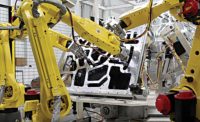Manufacturing engineers have two options for obtaining an automated assembly system. They can get each component—an automatic screwdriver, a rotary indexing dial, a gripper—from individual suppliers and integrate the parts themselves. Or, they can ask one supplier to deliver a turnkey machine.
This was the choice faced recently by a European automotive supplier. It needed equipment to automatically install screws in door hinge assemblies. The supplier got that—and a lot more—from DEPRAG Schulz GmbH & Co. in Amberg, Germany.
DEPRAG engineers designed and built a manually tended automated assembly system based on a rotary indexing dial. Measuring less than 4 meters in every dimension, the system took 14 weeks of work from the date of the order to acceptance by the customer.
“If the term ‘one-stop-shop’ hadn’t already existed, I would have said that it was coined especially for DEPRAG,” says Jürgen Hierold, sales manager. “This is a huge benefit for our customers. We make every component of the system ourselves. We are able to design and construct the equipment to tried and tested standards, and that has a positive effect on price and delivery lead times.”
After consultation with the customer, DEPRAG’s engineers decided that a traditional rotary indexing dial would be the best solution for the job. The machine was designed with eight positions. Initially, two of the positions will not be used, but will be available if the assembly operation is ever expanded.
“In a cycle time of under 10 seconds, it joins the door hinges, monitors them for quality and sends them on, ready for packing,” says systems engineer Markus Solfrank.
At position 1, a linear conveyor brings three preassembled components for the hinge housing to an operator. The operator places the parts into a fixture on the dial. The parts are then transferred past position 2, which is unused, to position 3.
There, two programmable, electronic Minimat-EC screwdrivers tighten two prefitted screws in the components to a precise angle. The screwdrivers then tighten two more screws that are delivered from an automatic feeder. These screws are driven to a specific torque. Each pair of screws has its own fastening parameters, and the screwdrivers’ controller automatically updates the tools on the fly. The controller also ensures that each screwdriving operation has been correctly completed.
The workpiece then moves on to station 4, where two plates are installed with a press. (The plates are necessary to adjust the hinge during final assembly of the vehicle.) The plates are fed with a vibratory feeder bowl and a belt-driven hopper. Electronic communication between the bowl and the hopper ensures a consistent level of parts in the bowl.
“A conveyor moves the separated plates in the correct alignment toward a swivelling magazine, into which two plates are placed opposite one another,” says Solfrank. “A dual gripper picks up the two plates and moves them to the press-fitting position, where a press inserts them with a force of 200 newtons. While that is happening, the next two plates are being placed into the swivelling magazine.”
At station 5, the plates are secured with two screws each. Two pneumatic Minimat screwdrivers tighten the screws to a specific torque. “For reasons of economy we selected two low-cost pneumatic screwdrivers for this station,” Hierold explains. “The technology is quite sufficient to achieve the correct torque.”
Just two threaded pins remain to be fitted, and this takes place at station 6. This station is equipped with one pneumatic Minimat screwdriver. “This screwdriver fastens the two threaded pins consecutively into the plates,” says Solfrank. “Instead of having two screwdrivers operating simultaneously at this station, we used just one for two reasons. First, the fastening job fits better into the cycle time, and second, this solution is particularly economical.”
The completed component then arrives at station 7, where a gripper lifts it, turns it 90 degrees, and places it on a linear conveyor for transfer to the packaging station.
The system will not allow an incorrectly assembled workpiece to continue to packaging. Each station transmits an “OK” or “not OK” signal to the system’s master control unit. An incorrectly assembled part is returned to the operator at station 1, where he places it aside. The operator can follow the assembly process on an easy-to-read touch screen interface.
DEPRAG’s U.S. office is located in Lewisville, TX. For more information, call DEPRAG at 972-221-8731 or visit www.depragusa.com.
Editor’s note: Whether you’re a systems integrator or the in-house automation team of an OEM, if you’ve designed a system that you’re particularly proud of, tell us about it. Send an e-mail to John Sprovieri, editor of ASSEMBLY, at sprovierij@bnpmedia.com, or call 630-262-3293.





